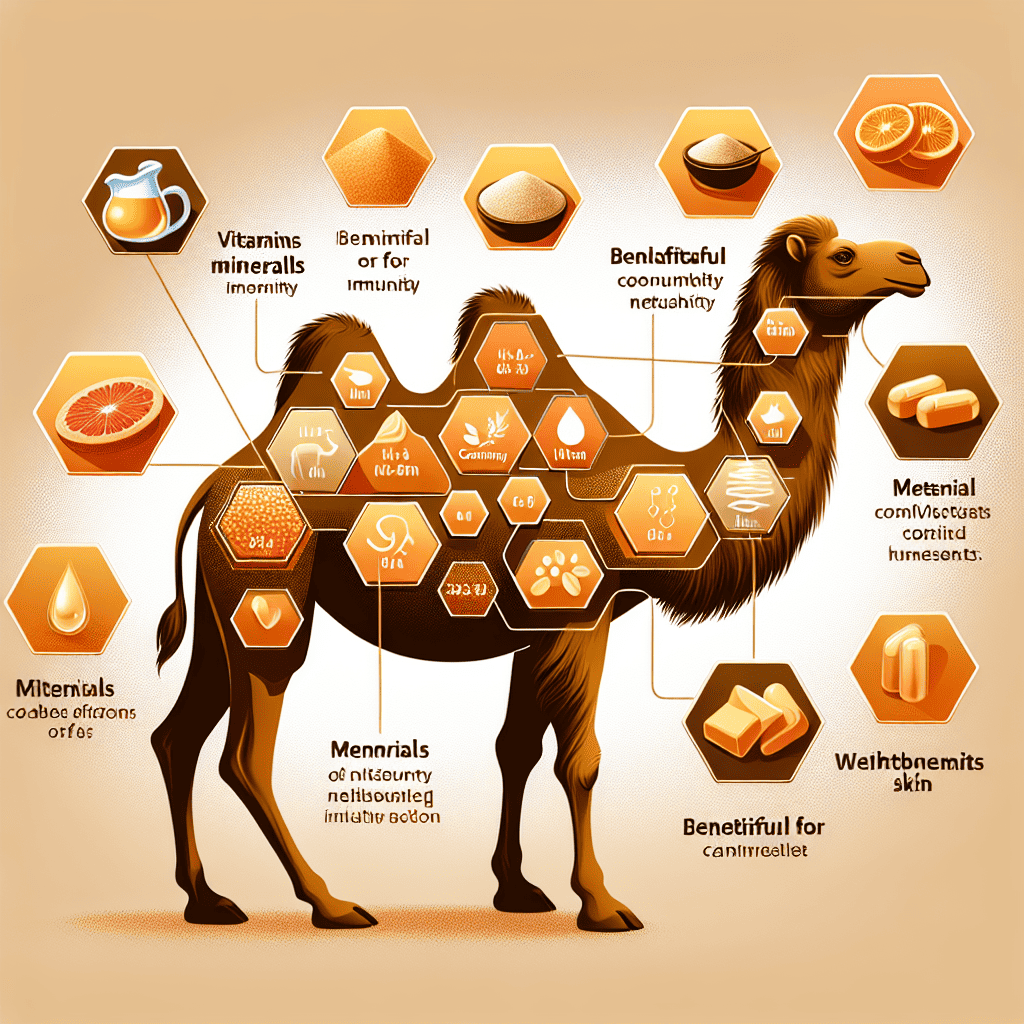Introduction: Camel fat, especially concentrated in the hump, offers numerous health and aesthetic benefits that have been cherished for centuries. In this article, we will explore the various advantages it provides, including its potential impact on nervous system health, skincare, hair care, and its culinary uses.
Table of Contents
The Health Benefits of Camel Fat
Camel fat, primarily found in the hump, offers a multitude of health benefits that have been recognized for their potential wellness enhancements. Let’s delve into some of the key advantages:
- Promotes Nervous System Health:
Camel fat is a rich source of essential nutrients that can have a positive impact on nerve health. Amino acids, which are the building blocks of proteins, play a crucial role in transmitting messages between the brain and the rest of the body. By including camel fat in the diet, individuals can ensure an adequate intake of amino acids, which may help in maintaining the health and functionality of the nervous system. Additionally, oleic acid, a monounsaturated fat found in camel fat, has been linked to various health benefits, including reducing inflammation and supporting overall nerve function.
Furthermore, the regular consumption of camel fat can potentially contribute to overall well-being by providing the body with essential nutrients that are necessary for maintaining optimal health. A well-functioning nervous system is essential for proper bodily functions and can influence various aspects of health, including cognition, mood, and muscle control. Thus, by incorporating camel fat into the diet, individuals may support their nerve health, which in turn can have a positive impact on their overall well-being.
Incorporating camel fat into the diet can be done in various ways, such as using it for cooking or as a spread. It can add a unique flavor profile to dishes while also providing the body with important nutrients. Additionally, camel fat can be a healthier alternative to some traditional cooking fats, as it is lower in saturated fats and rich in beneficial compounds like oleic acid. While moderation is key when adding any type of fat to the diet, integrating camel fat into a well-balanced meal plan may offer potential benefits for nerve health and overall wellness.
- Respiratory Health and Other Benefits:
Camel fat consumption has been shown in studies to potentially play a role in preventing chronic respiratory conditions like asthma. This suggests that including camel fat in the diet may offer some benefits for respiratory health. Asthma is a common chronic condition that affects the airways in the lungs, leading to symptoms like wheezing, coughing, and shortness of breath. By incorporating camel fat into the diet, individuals may be able to reduce the risk or severity of asthma attacks, although more research is needed to fully understand the mechanisms behind this potential benefit.
Apart from its role in respiratory health, camel fat has also been used traditionally for various health concerns. In some cultures, camel fat has been applied topically to help alleviate symptoms of external hemorrhoids. The anti-inflammatory properties of camel fat may provide relief from discomfort and reduce inflammation associated with hemorrhoids. Additionally, camel fat has also been consumed to promote intestinal health. It is believed to have antimicrobial effects, helping to eliminate harmful bacteria and worms from the digestive system. By maintaining a healthy balance of gut flora, camel fat consumption may contribute to overall gastrointestinal well-being.
The traditional uses of camel fat suggest a wide range of potential health benefits beyond just respiratory health. From relieving symptoms of external hemorrhoids to promoting intestinal health by eliminating harmful organisms, camel fat has been valued for its medicinal properties in various cultures. While modern research is beginning to explore the therapeutic effects of camel fat, more studies are needed to validate its traditional uses and understand the full extent of its health-promoting properties. Incorporating camel fat into a well-balanced diet may offer not only potential respiratory benefits but also support overall well-being and digestive health.
The Aesthetic Benefits of Camel Fat
Beyond its health advantages, camel fat is revered for its aesthetic benefits, particularly in skincare and haircare routines. Let’s explore how camel fat can enhance your beauty regimen:
- Skincare Benefits:
Camel fat, when melted and applied topically, offers a myriad of skincare benefits. Not only does it provide intense hydration to the skin, but it also helps in achieving a glowing complexion. The fatty acids present in camel fat deeply nourish the skin, leaving it supple and soft. This natural emollient is particularly useful for individuals with dry skin conditions, as it helps in preventing moisture loss and restoring the skin’s natural elasticity. Moreover, the moisturizing properties of camel fat extend beyond basic hydration; it can also help in revitalizing the skin’s texture and tone, making it a versatile skincare ingredient.
Furthermore, melted camel fat is known for its efficacy in addressing specific skin concerns like sagging skin post-pregnancy or weight loss. The emollient nature of camel fat helps in firming and toning the skin, restoring its resilience and combatting the effects of gravity. Regular application of camel fat on areas prone to sagging can aid in tightening the skin and improving its overall appearance. Additionally, the nourishing components in camel fat contribute to enhancing the skin’s firmness and reducing the visibility of fine lines and wrinkles, making it a valuable addition to anti-aging skincare routines.
Another notable benefit of using melted camel fat on the skin is its ability to strengthen the skin’s natural barrier. The fatty acids present in camel fat play a crucial role in maintaining the skin’s lipid layer, which acts as a barrier against external aggressors and pollutants. By reinforcing this protective barrier, camel fat helps in shielding the skin from environmental damage and preventing moisture loss. This not only promotes healthier and more resilient skin but also aids in reducing sensitivity and irritation. Overall, the application of melted camel fat as part of a skincare regimen can lead to improved skin health, appearance, and vitality.
- Haircare Benefits:
Camel fat is a natural ingredient that offers numerous benefits for hair health. Its ability to provide nourishment from the roots to the tips of the hair not only promotes scalp health but also strengthens the hair strands. This nourishing effect helps in reducing breakage, making hair less prone to damage. Additionally, camel fat’s richness in nutrients such as fatty acids and vitamins can play a vital role in preventing hair loss by ensuring that the hair follicles receive essential nutrients for healthy growth. By improving hair density, camel fat contributes to fuller and thicker-looking hair.
Furthermore, the moisturizing properties of camel fat contribute to enhancing the softness of the hair. This can be particularly beneficial for those with dry or brittle hair, as the hydrating effect helps in restoring moisture and improving the overall texture of the hair. Regular use of products containing camel fat can result in smoother and more manageable hair, making styling easier and reducing frizz. The softening properties of camel fat can also contribute to a healthier appearance of the hair, giving it a natural shine and luster.
Incorporating camel fat into hair care routines can be a holistic approach to maintaining hair health and addressing common concerns such as breakage, dryness, and loss of volume. Its nourishing, strengthening, and moisturizing properties make it a valuable ingredient for promoting overall hair wellness. Whether used in hair oils, masks, or treatments, camel fat can provide a range of benefits that help in achieving strong, soft, and vibrant hair. Embracing the natural goodness of camel fat in hair care can be a sustainable and effective way to support the health and beauty of your hair.
How is Camel Fat Used?
Camel fat can be utilized in various ways to harness its benefits, whether for health, beauty, or culinary purposes. Here are some common methods of using camel fat:
- Direct Application to Skin:
Camel fat has been used in certain cultures as a traditional remedy for various skin concerns due to its moisturizing and nourishing properties. When melted and applied directly to the skin, camel fat forms a protective barrier that helps to lock in moisture. This can be particularly beneficial for individuals with dry skin or those experiencing issues like flakiness and roughness. The fatty acids present in camel fat, such as linoleic acid, oleic acid, and palmitic acid, contribute to its emollient effects, leaving the skin feeling soft and supple.
Moreover, camel fat contains vitamin E, a powerful antioxidant known for its ability to protect the skin from free radicals and environmental damage. By applying camel fat topically, individuals may help to combat the signs of aging, such as fine lines and wrinkles, and maintain a more youthful appearance. The moisturizing and rejuvenating properties of camel fat make it a popular choice for those looking to improve skin elasticity and firmness. It is believed that the unique composition of camel fat closely resembles the natural oils produced by the skin, allowing for better absorption and integration into the skin’s barrier function.
While the anecdotal benefits of using camel fat for skincare are widely recognized in some communities, it is important to note that individual experiences may vary. As with any natural remedy, it is advisable to perform a patch test before widespread use to check for any adverse reactions. Additionally, consulting with a dermatologist or skincare professional can provide personalized insights and recommendations based on specific skin concerns. By incorporating camel fat into a regular skincare routine, individuals may discover a natural and effective way to address dryness, improve skin texture, and promote overall skin health.
- In Cooking:
Camel fat has gained popularity as a flavorful alternative to more common cooking oils due to its distinct taste and high heat stability. When used in cooking, camel fat adds a unique flavor profile to dishes, making it a sought-after choice among chefs and home cooks alike. Its ability to withstand high temperatures without smoking or burning makes it ideal for various cooking methods such as frying, sautéing, and roasting, where maintaining the integrity of the fat is crucial for the overall taste of the dish.
In addition to its culinary advantages, camel fat can also be combined with other ingredients such as honey to create a delicious and aromatic blend. The combination of camel fat and honey offers a rich and slightly sweet flavor that can elevate the taste of both sweet and savory dishes. Furthermore, camel fat is known for its potential health benefits. It is rich in monounsaturated fats, which are considered heart-healthy fats that can help lower bad cholesterol levels and reduce the risk of heart disease. Moreover, camel fat contains certain vitamins and minerals that are beneficial for overall health and well-being.
When incorporating camel fat into recipes, it is important to consider its unique taste and adjust seasoning accordingly to complement the flavor profile. Experimenting with camel fat in different dishes can open up new culinary possibilities and add a touch of exoticness to traditional recipes. Whether used as a cooking oil, combined with other ingredients, or for its potential health benefits, camel fat continues to intrigue and inspire culinary enthusiasts looking to explore new flavors and cooking techniques.




